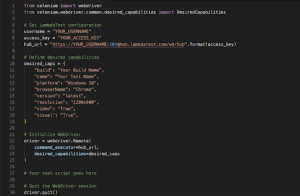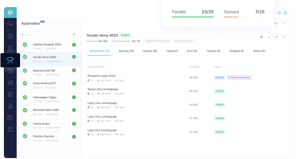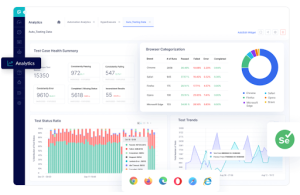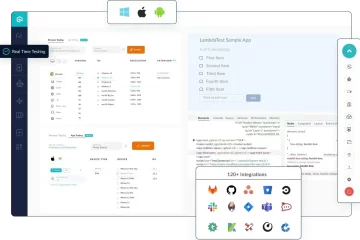What Are Some Tips for Managing Complex Software Testing Requirements?

Modern applications have reached new limits in terms of accessibility and usability. However, this increase in the application functionality has also led to increased complexity in the app development and testing cycle. For instance, while working with these apps the app developers not only have to verify the functioning of the individual elements but also the stability of the combined infrastructure. Modern testing processes like mobile app testing and cross-browser testing help app developers boost the quality and efficiency of the overall testing environment. There are also various tools and frameworks easily available in the market that can help simplify the application testing infrastructure.
By implementing some tips, app developers can efficiently manage multiple complex software testing scenarios and deal with the project requirements. So, with this article, we are going to explore some of the most efficient tips that can help the developers in this process.
Table of Contents
Exploring Modern App Testing Standards
Earlier, apps were designed to serve one purpose at a time. Moreover, the application testers had to create the apps for only one platform as the desktop was the only way of accessing apps in earlier times. However, with the advancement of technology, things have changed massively in the app development industry. Currently, end users can access multiple apps on various portable devices like smartphones, tablets, and even smartwatches. Moreover, the end users prefer apps that can perform multiple functions at the same time so that they do not have to look for dedicated apps for every daily task. To keep up with the rising demands of the end users, the app developers had to accordingly adjust the testing and development parameters.
So, now app developers have to create apps that not only function on both mobile and desktop platforms but also have access to multiple elements at the same time. Due to all of these complexities, certain unforeseen circumstances like bugs, errors, and even false positive test reports might arise in the testing infrastructure. If unnoticed, these errors can dramatically hamper the functioning of the app leading to frequent crashes and negatively impacting the user base.
Role of Automation Testing in Modern Testing
The app developers can massively reduce the reliability and efficiency issues in the testing cycle with the integration of automation testing. This is because automated test cases do not rely on human involvement and can run 24 hours round the clock with the help of automated test scripts. These test scripts provide the required information so that the system can emulate human interactions while communicating with the application undergoing the development process. The primary goal of automation testing is to analyze the behavior, stability, and functioning of the app when it is exposed to various real-world scenarios.
The proper implementation of automation testing in modern app development standards can boost the testing cycle in the following ways:
- Since automation testing can automatically run the test cases, it is highly efficient and massively reduces the overall test execution time. Moreover, the automatic creation of test cases reduces the risk of human error.
- By using automation testing while working with repetitive test instances like data analysis testing and regression testing, developers can focus on the creative areas of the project. For instance, they can come up with new features that can be rolled out in the future updates of the app.
- Automation testing also helps boost the testing efficiency by allowing the integration of parallel test execution. This is the process of initiating and running multiple test instances on different configurations and machines at the same time.
- While using automation testing, the app developers can also properly manage the company’s time and resources. For instance, in the long run, the company can eliminate the requirements of having a human device testing lab.
Tips for Managing Complex Software Testing
To assist the new automation testers and developers, we have created a list of some of the most important tips for dealing with complex testing instances:
-
Analysing the App Requirements:
Before implementing any strategy for dealing with the app testing requirements, it is very important for the application developers and testers to personally go through these requirements. During this process, they should analyze the target audience, the intended use case for the app, and its present market competitors. This data will help them to customize the test plan and their expectations from the test report.
-
Prioritizing the App Requirements:
While working with a complex application, the app developers have to serve multiple expectations and requirements. So before beginning the testing process, it is very important to sort the requirements according to their priority in terms of app usage and target audience. By using this priority list, the App developers can efficiently manage the test cases and ensure that at least the basic structure of the application is usable irrespective of any situation.
-
Use of Cloud Platforms:
While the application developers focus on improving the simplicity of the application, it is very important to keep an eye on the test accuracy. The use of real device testing parameters can help maintain this goal. The app developers can use real device testing by running the test cases on thousands of real devices through remote servers. It is possible with the help of cloud platforms like LambdaTest. These platforms also allow access to legacy devices and the execution of test cases from anywhere in the world. Cloud platforms can also merge test reports from multiple testing sources for improved efficiency.
-
Breaking Down the Complex Requirements:
In most cases, the app developers will realize that the complex testing requirements are made up of multiple smaller and manageable parts. So, the automation developers and testers need to break down the complex scenarios and divide the work among all the members of the testing team. This approach will help to ease the plan and execute the test cases more efficiently.
-
Creating a Traceability Matrix:
Using a traceability matrix, the app developers can link multiple test cases based on the specific requirements of the target test element. This approach will ensure that all the requirements are covered by one or more test cases and help track the testing process. Using this approach, the application developers can ensure that all the elements of the app undergo a thorough testing process and there isn’t any untested element on the app.
-
Requirements Documentation:
While working with complex apps, it is critical to maintain up-to-date and clear documentation. Using these documents, the app developers can record and update all the changes that need to be tracked. This documentation will also help the application developers to analyze the role of various elements in the functioning of the app. Certain cloud platforms like LambdaTest help app developers maintain a real-time test activity log. This log keeps track of the failed test cases, passed test instances, and even the currently running ones. Using this reference, the app developers can ensure that they can avoid all the previously known errors in future projects.
-
Integration of Test Management Tools:
We recommend the app developers consider the integration of modern test management tools like TestRail and Jira. Using these tools, the developers will be able to better organize and track the test instances. It also helps to keep a record of all the test requirements and the status of the test execution process. Modern test automation frameworks like Selenium and Appium, provide native support for test management tools.
-
Use of Test Automation:
As we already discussed earlier, test automation can massively reduce the complexity of modern application development cycles. This is because it not only removes the human involvement but also runs the test cases based on multiple parameters. Moreover, the integration of artificial intelligence with modern test automation massively boosts the quality, efficiency, and dependability of the test instances.
LambdaTest and How it Boosts Modern Cross-Browser Testing
As we already mentioned, cross-browser testing is one of the most important parameters of the modern app development cycle. By using LambdaTest, the app developers can execute automated cross-browser test cases on web apps. The LambdaTest platform also provides an artificial intelligence-integrated way of initiating and executing the test cases on the respective elements of the app.
To properly understand the role of LambdaTest API and LambdaTest real device testing cloud, we can go through the following parameters:
- While using this platform, app developers can import automation test cases from various well-known frameworks like Selenium, Appium, Playwright, and even Cypress. With the Selenium test cases, the app developers can execute the test instances on more than 3000 browser versions at the same time.
- Using the Selenium Grid, the app developers can execute automated cross-browser testing on different browser versions, operating systems, and even legacy device versions. Using the following code snippet, the app developers can natively execute automated cross-browser testing with LambdaTest.

- The LambdaTest real device testing cloud allows the app developers to run thousands of different test instances on different real devices by combining remote servers with parallel testing.

- After executing the test instances, LambdaTest will generate detailed test reports that will consist of vital information like screenshots and videos that were captured during the testing process. It also consists of a test activity log that stores all the information regarding the execution process. So, the app developers can easily perform the debugging processes on the faulty elements of the app.

- LambdaTest also has elaborate documentation on the official website providing information about various features and methods. The official website explains all the required information in simple language and by using sample test cases. It also has a dedicated support system consisting of over-the-phone support, live chat, and even a mailing feature. Using the documentation and support system, the new automation testers and developers can gain adequate information whenever they are stuck with any feature. LambdaTest also maintains an open-source community of enthusiastic developers who are always ready to help newcomers in the market.
The Conclusive Views
All the tips that we discussed in this article will help the developers efficiently handle complex software testing scenarios. Moreover, the integration of automation testing and cross-browser testing will further boost the quality of the application undergoing the development process. In this regard, the app developer should also learn about all the new trends and innovations in the segment of modern app development. It is also important to learn the requirements of the target audience and customize the application according to these data. Finally, it is very important to consider the productivity of the testing environment, requirements of the app project, and preferences while designing the test plan.








